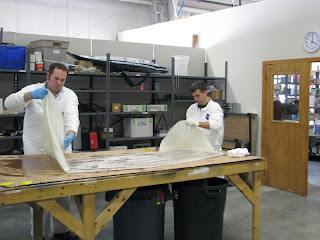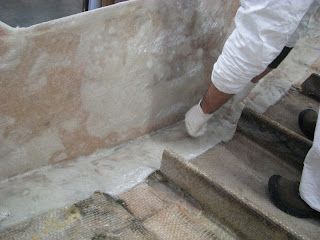Installment XIII in the reconstruction blog of a 1973 Mako center console

In this next step we will
wet out and layup one layer of
biaxial cloth inside the transom before bonding in new transom core. Our thinking - the
1708 biaxial will bolster strength and makeup for any minor deficiencies in the old transom skin.

Transfering the wet-out cloth to the transom is most certainly a messy two person procedure. An alternate method is to bring dry cloth over and wet it in place.


Once aligned, we chased out all air from under the cloth using
laminating rollers and
spreaders.


Notice the Biaxial cloth does not wet out completely clear. In hindsight we learned that
styrenes in this "mat type" fiberglass cloth do not bond with epoxy as they do with polyester resin. (Biaxial is woven cloth one side and mat on other side.) Engineers at West System acknowledge this quirk between mat type fiberglass and epoxy in their literature. They also state it does not negatively impact the finished composite strength (from extensive testing). Yet any mat based fiberglass wetted out with epoxy will be less conformable (i.e. harder to drape over a shape) than the same mat cloth using
polyester resin. Wow, who knew? Certainly not these two guys. Also, if this were a critical application where it needed to be clear, biax and epoxy should not be your mix of choice (i.e. a cold molded hull where beautiful mahogany shows clear through). Lucky for us, biax and epoxy are fine in this hidden and flat application. Henceforth though, I think we'll stick to regular
4 to 8 oz cloth compatible with epoxy.

With the
biaxial cloth in place, we're now ready to bed in the core.
 In this next step we will wet out and layup one layer of biaxial cloth inside the transom before bonding in new transom core. Our thinking - the 1708 biaxial will bolster strength and makeup for any minor deficiencies in the old transom skin.
In this next step we will wet out and layup one layer of biaxial cloth inside the transom before bonding in new transom core. Our thinking - the 1708 biaxial will bolster strength and makeup for any minor deficiencies in the old transom skin. We mixed up several batches of West System neat epoxy (no additives) and wet out the 1708 cloth on the table. There is a science to estimating the amount of epoxy needed to wet out cloth. We don't make any pretenses to be scientists; our formula= mix many small batches til we don't need anymore. We gently squeegeed it over the surface with a single edge spreader and let the cloth soak in the epoxy. Typically the cloth will become translucent as fibers soaks up and bond to the resin. This did not hold true for the biax, but more on that later.
We mixed up several batches of West System neat epoxy (no additives) and wet out the 1708 cloth on the table. There is a science to estimating the amount of epoxy needed to wet out cloth. We don't make any pretenses to be scientists; our formula= mix many small batches til we don't need anymore. We gently squeegeed it over the surface with a single edge spreader and let the cloth soak in the epoxy. Typically the cloth will become translucent as fibers soaks up and bond to the resin. This did not hold true for the biax, but more on that later. Transfering the wet-out cloth to the transom is most certainly a messy two person procedure. An alternate method is to bring dry cloth over and wet it in place.
Transfering the wet-out cloth to the transom is most certainly a messy two person procedure. An alternate method is to bring dry cloth over and wet it in place.
 Once aligned, we chased out all air from under the cloth using laminating rollers and spreaders.
Once aligned, we chased out all air from under the cloth using laminating rollers and spreaders.
 Notice the Biaxial cloth does not wet out completely clear. In hindsight we learned that styrenes in this "mat type" fiberglass cloth do not bond with epoxy as they do with polyester resin. (Biaxial is woven cloth one side and mat on other side.) Engineers at West System acknowledge this quirk between mat type fiberglass and epoxy in their literature. They also state it does not negatively impact the finished composite strength (from extensive testing). Yet any mat based fiberglass wetted out with epoxy will be less conformable (i.e. harder to drape over a shape) than the same mat cloth using polyester resin. Wow, who knew? Certainly not these two guys. Also, if this were a critical application where it needed to be clear, biax and epoxy should not be your mix of choice (i.e. a cold molded hull where beautiful mahogany shows clear through). Lucky for us, biax and epoxy are fine in this hidden and flat application. Henceforth though, I think we'll stick to regular 4 to 8 oz cloth compatible with epoxy.
Notice the Biaxial cloth does not wet out completely clear. In hindsight we learned that styrenes in this "mat type" fiberglass cloth do not bond with epoxy as they do with polyester resin. (Biaxial is woven cloth one side and mat on other side.) Engineers at West System acknowledge this quirk between mat type fiberglass and epoxy in their literature. They also state it does not negatively impact the finished composite strength (from extensive testing). Yet any mat based fiberglass wetted out with epoxy will be less conformable (i.e. harder to drape over a shape) than the same mat cloth using polyester resin. Wow, who knew? Certainly not these two guys. Also, if this were a critical application where it needed to be clear, biax and epoxy should not be your mix of choice (i.e. a cold molded hull where beautiful mahogany shows clear through). Lucky for us, biax and epoxy are fine in this hidden and flat application. Henceforth though, I think we'll stick to regular 4 to 8 oz cloth compatible with epoxy.
No comments:
Post a Comment